

































 The three basic necessities which sustain life are:
The three basic necessities which sustain life are:Without water or any other fluids, a person will die in about three days.
Therefore, since water is one of life's most basic necessities, it is a subject we should not take for granted.
Water is necessary to properly digest food. (Note: If you don't have water, then do NOT eat regardless of how hungry you become.)
Our urine is almost all water and it is how our body flushes and rids itself of toxic wastes.
Water facilitates normal bowel movements which helps prevent constipation.
In one day the average person loses between 2 to 3 quarts of water through their urine, sweat, and normal breathing. If a person doesn't replace that lost water, then dehydration begins to occur.
At 2% dehydration, thirst is perceived.Pause and reflect on that for a moment. A person loses 2 to 3 quarts of water every day as a result of their normal body functions. Which means if a person doesn't get any fluids for about three days, they will die.
Most people have never thought about the above because they have NEVER been personally confronted with a extended shortage of fresh safe drinking water at any time in their lives.
Water is VERY heavy.
One gallon of water weighs about 8.5 pounds inside a thin-walled clear plastic water jug.
You can't carry enough water with you between locations to last for very long.
If one person consumes 2.75 quarts of water each day, then one person will need 250 gallons of water per year. A family of four will need 1,000 gallons of water per year. One-thousand gallons of water weighs about 4.25 tons. (And that does NOT include water for washing your hands or for washing dishes.)
With the passage of time, bottled water will gradually become unfit to drink for a variety of reasons. However, it can be reprocessed to make it fit for human consumption. Several different options are discussed below.
If commerce were disrupted by either a natural or manmade disaster, one of the first things a person should do is evaluate their water situation. This involves three different but related issues:
1. How much water is on hand right now?If you are at home when the emergency occurs, then immediately check to see if the faucet water pressure is still on. If it is then fill every possible container in the house that will hold water and not leak. For example: pots, pans, plastic containers, drinking glasses and drinking cups, bowls, and every sink and bathtub.
If the water is off, you still have three sources of clean drinking water:Even if the water pressure is off, there is still some water inside the water pipes in your home or apartment. That water can be drained from the water pipes (using gravity) by opening the LOWEST cold water faucet in your home, which will usually be on the first floor, or the basement, or an outside water faucet. However, you will also need to open the highest cold water faucet in your home to allow air to enter the cold water pipes so the water can flow out the lowest water faucet into your collection container. This will drain all the water out of your cold water pipes but NOT your hot water pipes.
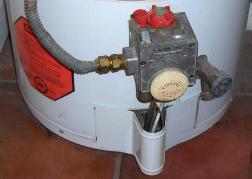
Most hot water heaters contain 40 gallons of clean water. However, BEFORE you remove that water you MUST turn off the power or turn off the gas to your hot water heater, or you could start a fire. Then open the faucet at the bottom of the water heater to gain immediate access to 40 gallons of reserve clean drinking water. This is enough emergency water to last a family of four for 20 days if they ONLY drink the water and don't wash with it. This is the BEST source of reserve drinking water for the average family because it is constantly being used and replaced inside the hot water heater prior to the emergency. Therefore it will be fresh and clean at the beginning of an emergency. (Note: Some hot water heaters do NOT have an easy access water value at their base. Prior to an emergency you should take a look at your hot water heater and determine if you can get to the water inside your heater. If you can't, then you might consider having a plumber install a standard water faucet value in the water line at the bottom of the hot water heater.)
Another source of water is canned foods because many canned foods are packed in water. When you open a can, serve the water in the can with the food. Never throw the canned water away if you are low on water.
Water that isn't safe to drink is toilet tank water and water inside the mattress of a water bed.
If you had the foresight to plan for an unexpected emergency, then you should have a stash of clean empty 2-liter plastic soda bottles stored somewhere out-of-sight. They are really nice for storing water because they are free (after you drink the soda), they are made of food grade plastic, they don't leak, they have a screw on cap to keep the water clean, they have an extremely long shelf life, and they are a convenient size to handle and use. The major disadvantage of the 2-liter bottles is that they don't stack well on top of one another.
If you have empty one-gallon plastic water jugs then you should also consider saving them for a future emergency. However, clean empty plastic milk jugs are NOT a good option because they will deteriorate with the passage of time and begin to leak.
After inventorying your water, the next step is to ration your water. During normal times, one person consumes about 3 quarts of water per day. No one I know drinks that much water each day. However, all of us drink some water, plus a variety of other fluids (coffee, tea, soda, juice, or whatever appeals to you). During hardship conditions, a person can survive on two quarts of water per day (two quarts is one-half gallon). If water is really in short supply, then one quart per day will keep a person alive, but they will begin to slowly dehydrate.
Everyone knows better, but after an extended period of time with little or no water, a person will drink all the water they can when it suddenly becomes available. If you do this, you will get sick. Force yourself to S l o w - - d o w n. Drink one cup of water every 10 minutes. Give your system a chance to absorb the water and send it where it is needed most. Don't overload your system and kill yourself.
You have inventoried and carefully rationed your water, but the emergency continues longer than you anticipated and you are running low on water. Before your water completely runs out, you should start replenishing it. Let's examine a number of different alternatives.
If you live in the country, or if you have a water well on your property, then you already know there is water in the bottom of that well. Drilled wells can be anywhere from about 25 feet deep up to a thousand feet deep or more. For approximately $1,000 it is possible to purchase a heavy-duty manually-operated complete hand water pump for wells that are 200 feet deep or less. It is not possible to hand-pump water from wells much deeper than about 200 feet. However, there is a very CHEAP way to get water out of almost any well, regardless of its depth.
If you know your electricity is going to be off for an extended period of time, and you are out of drinking water, and you have no other way to get drinking water, then you can manually remove the water from your well.
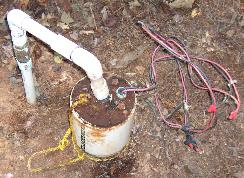
There are many different well configurations but a typical one is illustrated in the picture on the right. First you MUST turn off the electrical power at the main circuit breaker box, even if the electricity is off. Then disconnect the electrical wires at the top of the well and protect them so they do not touch one another or any other object. You may also need to disconnect the plastic pipe or hose connected to the top of the well piece. Next you will need the correct size wrench to remove the large bolts which secure the top piece to the well. After removing the bolts, remove the top piece and you will probably find three things: a very long flexible heavy-duty hose, a water-resistant rope, and some electrical wiring, all of which go down into your well and are attached to the well pump in the bottom of the well. You can gradually pull up on the rope (or the flexible hose if absolutely necessary) and it will bring the well pump up out of the well. Don't pull on the electrical wiring because it is not intended for that purpose. After removing the well pump you will have exposed the entire shaft down to where your water is.
Depending on the depth of the well, the diameter at the bottom of the well shaft will probably be a little smaller than the visible diameter at the top of the well shaft. Therefore, select a container that is at least 1 or 2 inches smaller in diameter than the well opening at its top. The container can be almost any length up to about 18 inches. The container should have a large mouth on top to allow water to enter and air to escape. One option would be an empty two-liter plastic soda bottle with its top cut off.
The next step is of critical importance. Untie the wet end of the well rope from the well pump. Tie the opposite dry end of the rope to a secure object. This will keep the rope from falling into the well if you lose your grip. Then securely attach the wet end of the well rope to the container. If the container somehow works itself loose from the rope, then you will NOT be able to get the container out of your well shaft. Also remember the container is going to be HEAVY with water when you pull it up. One option would be to make a strong net and put your container inside the net. Then tie the rope securely to the net.
Then put a relatively heavy clean, sterile object in the bottom of the container so the container will sink when it reaches the water level. Then slowly lower the container on the end of the rope by hand until it reaches the bottom of the well. You will know you have hit bottom when the rope has some slack in it. Wait for the container to fill with water and then pull it up. Repeat as often as required. When finished, carefully cover the exposed well head to prevent foreign materials from entering and contaminating your well water.
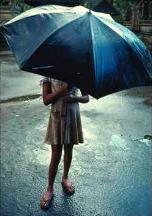
For the average person, the best source of replacement drinking water will probably be rain water. Although this is an excellent source of safe drinking water, it is unpredictable in regards to timing and quantity. However, for most people, this is probably the cleanest source of replenishment drinking water they will have access to on a regular but intermittent basis.
Regardless of where you live in the world, if you can catch the rain water BEFORE it comes in contact with anything, then it is safe to drink without any special treatments. Even when you take acid rain into consideration, this is still a true statement. However, if there is a nuclear, chemical, or biological war at some point in the future, then rain water may not be safe to drink for some period of time. You will have to use your own judgment in that situation. One of the portable commercial water filters described below would be appropriate in those types of unusual and hazardous situations.
If the air contains smog, pollen, or any other unpleasant stuff, then the rain will usually clean that stuff out of the air during the first 20 to 30 minutes of a good rain shower. Therefore, when it begins to rain you should wait about 30 minutes and then start collecting the clean rain water in a container. (Note: If you are seriously low on water and you are forced to collect the rain water during the first few minutes when it starts to rain, then you should process that water through one of the filters described below.)
Be creative. Think about what you have available that you can put outside to catch and hold rain water, or channel rain water through a partially open window into a big pot. Remember that it usually rains one-inch or less each time it rains. You need a large surface area to collect enough rain water to drink. A drinking cup or glass will not be enough. Even a 5-gallon cook pot is too small to just put outside by itself because it will only collect one-inch of water in the bottom of the pot.
Something like a child's inflatable swimming pool would be ideal, if your family already owns one. A 6-foot diameter pool would collect about 17 gallons of water if it rained one-inch. An 8-foot diameter pool would collect about 31 gallons of water if it rained one-inch. (Note: One gallon of water = 231 cubic inches of water.)
Or you could secure a clean 10' by 12' tarpaulin (or a clean thick sheet of plastic) in a manner where it slopes downward into a "V" shape towards a large 5-gallon pot (or other large container). Tarpaulins are commonly called tarps. With this size tarp you could collect about 70 gallons of water if it rains one-inch in your area (if you keep emptying and replacing your 5-gallon pot). However, you will need to secure your tarp very carefully because it is frequently very windy during a rain storm. Determine the primary direction in which the wind is blowing and then secure your tarp facing the wind at an upwards angle so the wind will blow a lot of the rain onto the surface of your tarp where it can collect and be channeled down into your water storage container.
In many areas it usually rains LESS than one-inch each time it rains, so it would probably be a good idea to use several tarps to collect rain water when it does rain. Many different tarp sizes are available, but for collecting rain water a tarp between 6' by 8' up to about 10' by 12' would be ideal. Smaller tarps don't cover enough area nor do they have very many other practical uses. Larger tarps are too heavy and they also have a limited number of other useful applications.
If you are trying to decide between an inflatable swimming pool or a good tarp, then the tarp would be the better choice. It is usually less expensive, more durable, easier to transport between locations, easier to set up and take down, requires less storage space when not in use, and it will provide an overhead shelter if you need to do some unexpected camping. When camping, the two most useful items are a good hunting knife and a high quality tarp.
Another option for collecting rain water would be to put clean bed sheets outside your windows. Let them get drenched in the rain, and then bring them inside and ring the water out of them by hand into a pot. Then stick them back out into the rain again. This is NOT the best method, but it will provide some drinking water.
If you live in a tall apartment building with a flat roof, then you might consider collecting rain water on the roof of your building using the large tarp or heavy-duty plastic sheet described above.
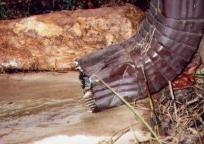
If you live in a house, you could collect the rain water from your roof gutters at the end of the down spouts. However, since the rain water has already been in contact with your roof, you will need to process it using one of the methods described later. The easiest way to collect roof rain water is to remove a few feet from the bottom of the gutter downspout and then put a large plastic container (or water barrel) directly beneath the shortened gutter downspout. The first few minutes of rain will wash a lot of stuff off your roof and down your gutter, so don't position the water collection container below the downspout until after it has rained about twenty-minutes.
If you are camping, then you will probably be sleeping under a weatherproof tarp, or you will have a rain fly above your tent. By using a little creative thinking, you can frequently set things up so the rain water runs off your shelter into a big pot or other container. This requires a little ingenuity on your part depending on what you have available, but I mention it because some of you will figure out a way to make this idea work for you.
Regardless of which method you use to collect the rain water, you will need to save the majority of your rain water until the next time it rains. Once again, if you have anticipated the possibility and seriousness of this type of unexpected emergency, then you should already have a reserve supply of clean, empty two-liter soda bottles or empty one-gallon plastic water jugs in which to store and save your rain water.
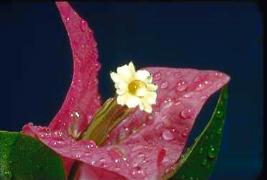
If it doesn't rain, then you could go outside at dawn and collect the morning dew. How? Take a clean thin dish cloth or thin wash cloth and wipe it gently over the damp grass and other non-poisonous flowers and shrubs. Periodically ring the water out of the cloth into a bowl. Repeat. This is very hard work that yields very small quantities of water. However, if you are low on water, this may be your only way to stay alive.
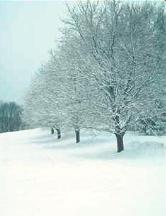
Bring the snow or ice inside your house and melt it down into water. You will be surprised at the small quantity of water you get from a big bucket of snow. If you are in the woods, put the pot of snow near the campfire and wait for it to melt.
If you have a black plastic trash bag, then put some snow inside the bag and place it in the direct sunlight to melt the snow.
If necessary, you can put the snow inside a small or medium size container. Then put the capped container inside your clothing (but not next to your skin) and your body heat will gradually melt the snow into water.
If you are concerned about the cleanliness of the snow, then you can boil the resulting water for 1 or 2 minutes before you drink it.
Never melt snow or ice inside your mouth. It will NOT relieve your thirst and you will dehydrate more quickly. Always melt the snow or ice first and then drink the resulting water.
Ground water is almost always contaminated. If you live in the country, then ground water is lake, pond, creek, stream, or river water. In the city, it is water flowing beside the sidewalks during a heavy rain. If no other source of water is available, then you may be forced to collect the only water you can find. But don't drink it until you purify it.
Even if the water looks crystal clear in a glass, it can still contain tiny organisms that will make you sick. You don't need a severe case of diarrhea or a high fever during difficult times. Like the old saying goes, it is better to be safe than sorry.
All sorts of animals, bugs, and birds live in the woods. When they get the urge to use the bathroom, they let it go wherever they happen to be at the time (as long as it isn't inside their nests). Later, when it rains, that waste material washes down into the nearest pond, lake, stream, creek, or river. Think about that if you are tempted to drink ground water without purifying it first. The chances are pretty high you will get sick even though there is no industrial pollution anywhere in the vicinity.
You MUST purify ground water using one of the methods which will be described later.
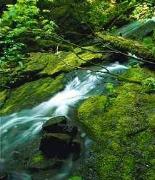
Water that is flowing swiftly over rocks is normally much cleaner than water in stagnant pools. If you have a choice, collect your water from a fast moving stream and then purify the water using one of the techniques described later.
Immediately after a rain the water in most streams and creeks will be muddy for a short period of time. At the very beginning of a rain shower you should check your water containers and fill them up if necessary before your normal water source (creek) gets really muddy.
When it rains, the water does two things. Some of it travels along the top surface of the ground and ends up in creeks and streams. But a lot of it soaks into the earth and some of it makes its way down to the natural water table in the area. The earth is an excellent water filter. If the water table is 100 feet or more beneath the surface, then the water there is usually safe for human consumption without any treatment. That's why people in the country drill deep wells - they want clean water that doesn't need treatment.
The next question is, how does a person get to that deep water out in the middle of the woods?
Do NOT waste your time trying to dig for it. It isn't worth the effort.
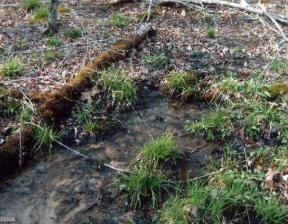
The best way is to find where a spring heads out. Let me explain. Because of gravity, water seeks the lowest possible level. You can usually find a stream or creek at the bottom of most hills or mountains. When you find one, begin walking upstream. Every now and then you will find a tiny feeder stream flowing into the main stream. The main stream will continue along the foot of the hill. Follow the tiny feeder stream up the side of the hill. Sooner or later you will eventually come to its source. It will just emerge from the ground. This is called the "head of the spring." The underground water table in this area is very close to the surface of the earth at this one spot and this particular exit point just happened as a result of nature. The water at the head of the spring hasn't had a chance to become polluted with lots of animal waste so it is the purest water you will find in the woods.
The head of a spring is normally a reasonable distance up the side of a hill or mountain. If there is any level ground near the spring head, this is usually an excellent place to set up camp. You avoid both the peak and bottom of the hill (high winds and flooding waters), and you are near a really clean reliable source of good water.
Usually (not always) this spring water it so clean it doesn't need to be boiled. I only know of one way to determine if the spring water contains harmful micro-organisms (called pathogens). Take a small water sample to your local water authority (county water service) and have it tested. They will tell you if it is fit for human consumption without being treated.
There is one more important consideration. After a really good rain shower, there are usually many, many feeder springs running into the main stream at the bottom of the hill. The water table rises and it leaks out all the holes near the surface of the earth. After a short period of time, most of these holes run dry because the water table falls back to its normal level. Therefore, the best time to look for the head of a spring isn't after a good rain. At that time they are easy to find but most will be undependable for the long haul. Wait until you have had a few good sunny days and then look for a spring head that is still running strong.
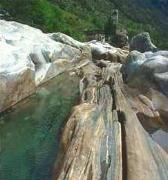
Most rain water will flow into a stream or soak into the earth. However, some of it will be caught in large natural depressions in boulders and other large rocks. Depending on the size of the depression (and other factors such as how long the water is in the shade each day, and how much of the rock is above ground to absorb the sun's rays, etc.) the rain water may not evaporate for many days after a rain. If you are trying to become familiar with a particular area of the woods, then you should mentally note these large depressions in a rock when you see them (even if they aren't filled with rain water at the time).
After a long dry spell, many springs and steams will run dry. If you are really desperate for water, then try digging in the lowest part of a dry spring or stream bed. Sometimes you will hit the water table two or three feet below the surface.
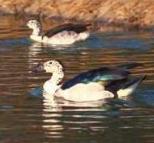
All of God's creatures need water to live. If you follow a heavily worn animal path downhill in the woods, it will probably lead to water. If you hear frogs in the distance, they are probably real close to some water. If you hear geese or ducks in the distance, they are probably real close to some water. Follow the animals and you will have a pretty good chance of finding where they get their drinking water. (Note: Bees also need water and they will build their hive in close proximity to a water source. If you see a bee, observe where it goes when it leaves the flower. It will either be heading to another flower, or to its hive. When returning to its hive, bees always fly in a straight line, or the proverbial bee line. Remember, the bee's hive is near some water.)
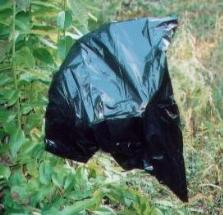
Put a large plastic bag around the leaves of a non-poisonous bush or shrub in the early morning and secure the open end of the bag to the wood branch with a string. During the heat of the day the green vegetation inside the plastic bag will release water vapor which will collect on the inside of your plastic bag and gradually drain down to the lowest edge of the plastic bag. When you check your bag at the end of the day you will discover about one-ounce of water (or less) in the lowest corner of the bag. Therefore, for this method to be of any practical value, you would need to have a lot of these bags attached to a lot of different plants every day.
I have read about solar stills but I have never personally experimented with one. However, I am passing this information on to you so you will know everything I know about water.
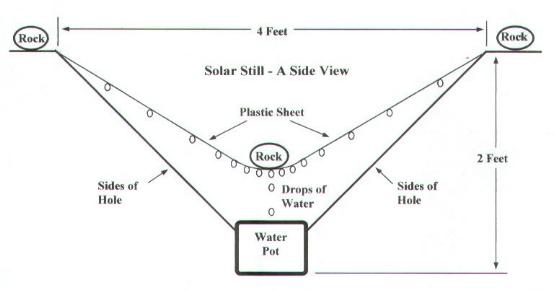
You will need a large plastic sheet or tarp to make a solar still. Dig a conical hole about four-feet wide at the top and coming to a point about two-feet deep. The bottom of the hole should be in the very center (equal distance from all sides). The slope of the sides isn't critical. Put a medium size pot at the very bottom of the hole. Then lay your plastic sheet over the top of the hole and put a medium size rock (about one-pound) in the center of the sheet just above the pot which will be directly underneath the sheet. Put heavy rocks on top of your plastic sheet all around the outside of the hole to keep the sheet from touching the inner sloping sides of the hole. The center of the sheet should be about 18 inches below the surface of the ground but about 6 inches above the pot. Wait 24 hours. Water vapor will form on the underside of your tarp and drain down to its lowest point (beneath your one-pound rock) and then drip into your pot in the bottom of the hole. On hot days and cold nights you can collect about one-pint of water per 24-hour period. I read somewhere that you can put moist green non-poisonous vegetation (leaves) near the bottom of the hole (but not in the pot) and this will increase the water yield from your still.
Solar still water is naturally distilled and it might be safe to drink without any treatments (such as boiling or chlorine). However, to avoid the possibility of getting sick it is a good idea to process the still water using one of the methods detailed below.
You will have to move your solar still every two or three days because you will have pulled all the available water from that hole until the next time it rains.
If you want to buy a plastic sheet to take with you when you go camping, then you can find them in the house paint section of most stores, including WalMart and most hardware stores. They are used by painters as drop-cloths to keep paint off the floor. They come in a variety of sizes and thicknesses. For durability, the 2-mil thickness is probably best. I have never built a solar water still but I have used these plastic sheets before. The 3-mil stuff will last longer but it is heavier and therefore you will burn more calories carrying it around in your backpack. The 1-mil stuff is lighter but it is very easily damaged (torn).
Note: I occasionally receive an email telling me that I omitted the long thin plastic tube that most survival manuals normally show extending from inside the water pot up along the side of the hole and out from under the plastic tarp. The purpose of the long thin plastic tube is to allow you to drink the water from the pot without disturbing your solar still setup. I intentionally omitted that tube or "long straw" for safety considerations. If I were using the above solar still to generate my drinking water then I would want to visually examine that water before I put it into my mouth and swallowed it. Therefore I did not include the "long straw" in the above drawing or in my description of how to build a solar still.
There are three different types of waterborne pathogens that make water unsafe to drink: protozoa, bacteria, and viruses.
Protozoa: They live in insects, or in cysts when on the outside of an animal. Examples of common waterborne protozoa are amoeba, giardia, and crypto(sporidium). Protozoa range in size from 1 to 100 microns, with the average being around 16 microns. They are easily removed from water by boiling. Because of their large size most of them are also easily removed by commercially available water filters (with the exception of the very small crypto). Some are relatively resistant to both chlorine and iodine chemical treatment methods. It has been estimated that 90% of the surface water in the United States is contaminated with protozoa.

Bacteria: A one-celled organism that can exist in the air and in water. The average size of bacteria is between 0.2 to 1.5 microns with some as large as 10 microns. They are easily removed by boiling, by chemical treatments, or by most good water filters. Fortunately, not all bacteria are life threatening. However, the most common life-threatening waterborne bacteria are dysentery (diarrhea), typhoid, (vibrio)cholera, campylobacter, E. coli, and salmonella.
Viruses: The most common waterborne viruses are hepatitis, yellow fever, polio(myelitis), rotavirus, and norwalk. Viruses are much smaller than bacteria. The average size of a virus is from 0.004 to 0.100 microns. They are easily removed by boiling or by chemical treatments. However, because of their extremely small size, they can pass through most water filters. However, some viruses will cling to other larger particles in the water which can be filtered out.
The incubation period prior to becoming extremely sick as a result of ingesting one of the above pathogens varies from a few hours to a few weeks, depending on the pathogen itself and the concentration ingested. Common symptoms include fatigue, fever, cramps, diarrhea, dehydration, and nausea. If not properly treated by a medical professional, these pathogens can eventually result in a person's death.
If you are in a remote area or if you can't get to a doctor quickly, then stay warm, drink plenty of safe fluids, and rest. You can help control the diarrhea with over-the-counter antidiarrheal medicines, and you can take over-the-counter pain relievers to help reduce the fever and minimize other associated discomforts. However, you should plan to get to a medical doctor as soon as possible.
After you have purified your water using one of the following techniques, do NOT recontaminate your water by allowing it to touch a pot, or spoon, or anything else that has been in contact with the unpurified water.
If your source of water is relatively cloudy or muddy (high turbidity) then allow it to stand in a large pot for twelve-hours to give the foreign particles an opportunity to settle to the bottom of the pot. Then slowly and carefully scoop the water out of the top of the pot without disturbing the sediment on the bottom of the pot.
Regardless of which of the following methods you use to purify your water, the first step is always the same. Begin by pouring your water through a standard paper coffee filter, or through a clean pillow case, or through a piece of denim cloth material. This will trap and remove any large impurities in the water. The same coffee filter can be used over and over again for several days (unless the water is muddy or dirty).
After you have pre-filtered your water, then you may use one of the following options to purify your water. The following alternatives are presented in order from the cheapest to the most expensive method.
Boiling is the BEST method for killing ALL the pathogens in the water. Even the most expensive commercially available water filter can't make that claim. Therefore, let's examine this method very carefully.
Water boils at approximately 212°F at sea level at a barometric pressure of approximately 30.3 inches of mercury. The boiling point of water decreases as the barometric pressure decreases. Therefore, the changing barometric pressure in your area has as much impact on the boiling point of water as the altitude at which you live. The following table illustrates this relationship:
| Altitude | 30" Mercury | 29" Mercury | 28" Mercury | 27" Mercury |
| Sea Level | 211.5 °F | 209.8 °F | 208.0 °F | 206.2 °F |
| 2,000 Feet | 208.0 °F | 206.2 °F | 204.4 °F | 202.5 °F |
| 4,000 Feet | 204.4 °F | 202.5 °F | 200.5 °F | 198.4 °F |
| 6,000 Feet | 200.5 °F | 198.4 °F | 196.3 °F | 194.1 °F |
| 8,000 Feet | 196.3 °F | 194.1 °F | 191.8 °F | 189.4 °F |
| 10,000 Feet | 191.8 °F | 189.4 °F | 186.9 °F | 184.3 °F |
All pathogens die rapidly at 185°F. Some pathogens die at lower temperatures. By the time the water has reached its boiling point (even at low barometric pressures), all the pathogens in the water are already neutralized.
Therefore, bring your water to a boil and let it hard boil for 1 minute. Or hard boil for 2 minutes on top of an extremely high mountain at very low barometric pressures. Boiling for more time doesn't help, and it results in more water being lost as steam, and it makes the water taste flatter. All pathogens are already dead by the time the water reaches its boiling point. There is no benefit to a pathogen being "more" dead.
Wait patiently for the water to gradually cool to a comfortable drinking temperature.
How to Improve the Taste of Boiled Water:Now let's look at some other ways to improve the quality of your drinking water. But don't forget, Boiling is Best, if you intend to actually drink the water in the next 24 hours or so. However, if you plan to store the water for an extended period of time, then one of the following methods should be considered.
The water should not be too cool. The water temperature should be 70°F or higher. If necessary, put the water in direct sunlight to raise the water temperature. The effectiveness of chlorine at killing pathogens diminishes rapidly at lower temperatures.
Add the required number of drops of chlorine liquid bleach (Clorox or store brand, unscented) to the water and wait one hour for the bleach to kill all the tiny organisms. If you can detect a faint chlorine smell in the water at the end of one hour, then it is safe to drink. If you can't smell the chlorine, then add the same amount of bleach a second time and wait another hour. If you can detect a faint chlorine smell, then the water is safe to drink. If you still can't detect the smell of chlorine, then discard the water because it contains too many germs. (Note: Always start with the minimum recommended amount of bleach and add a little more if necessary. Too much chlorine is harmful to your body.)
The water should not be too cool. The water temperature should be 70°F or higher. If necessary, put the water in direct sunlight to raise the water temperature. The effectiveness of chlorine at killing pathogens diminishes rapidly at lower temperatures.
Put 1/96 of an ounce (a pinch between thumb and finger) of 68% Calcium Hypochlorite granules into one gallon of water. Wait one-hour. If you can detect a faint chlorine smell in the water, then it is safe to drink. If you can't smell the chlorine, then add another “pinch” and wait another hour. If you can detect a faint chlorine smell, then the water is safe to drink. If you still can't detect the smell of chlorine, then discard the water because it contains too many germs. (Note: Always start with a small amount of Calcium Hypochlorite and add a little more if necessary. Too much chlorine is harmful to your body.)
The shelf life of liquid bleach (sodium hypochlorite) is much shorter than the dry 68% Calcium Hypochlorite granules. Therefore, if you wish to store hypochlorite for emergency purposes, the best choice is the dry granules.
Liquid Bleach: If you have dry 68% Calcium Hypochlorite granules, and for some reason you need liquid bleach, then you may dissolve one-ounce of 68% granules in one-pint of water and you will have a 5.25% liquid bleach solution.
The water should not be too cool. The water temperature should be 70°F or higher. If necessary, put the water in direct sunlight to raise the water temperature. The effectiveness of iodine at killing pathogens diminishes rapidly at lower temperatures.
Add the required number of drops of iodine to the water and wait one hour.
Iodine has a printed expiration date on the bottle. When that date has expired, the iodine will have lost some or most of its original strength. Therefore, iodine is generally not the chemical of choice for long-term survival situations.
Caution: Iodine water treatment methods can NOT be used by pregnant women, or nursing mothers, or individuals with thyroid conditions. In addition, long-term exposure to iodine can contribute to liver damage.
Although iodine is one way to purify water, it is NOT a preferred method. Any of the above methods is superior to the use of iodine.
Most commercially available water purification tablets are based on the use of either chlorine or iodine as their primary active ingredient. Both chlorine and iodine have a relatively short shelf life before they begin to lose their full strength and effectiveness. If you happen to have some of these tablets and they have passed their expiration date, then you should replace them.
The best overall method for improving the quality of water, but also the most expensive, is to use a commercial water filter, but not one that permanently connects to your home water system because it requires water pressure to function properly.
The one potential disadvantage of commercial water filters (not purifiers) is that they cannot remove 100% of ALL virus pathogens. Fortunately, waterborne virus pathogens are NOT a common problem in most areas. Therefore, unless there has been an outbreak of viral diseases in your area, then waterborne viruses will probably not be a problem with your water supply. However, if there has been a recent outbreak of viral diseases, then add the appropriate quantity of chlorine to the water, wait one-hour, and then put that treated water through one of the following filters.
Two Quick Definitions:Many people add a variety of water softeners, water filters, and water purifiers to the plumbing in their homes to improve the quality of the water normally available at their place of residence. These filters depend on water pressure and/or electricity to function properly. Neither water pressure nor electricity can be depended on during either short-term or long-term survival scenarios so these types of water filters will not be discussed here.
Short-term emergencies, such as hurricanes or tornados, are extremely serious but life gradually returns to normal after the danger has passed. Unless your area was completely demolished, most services are restored in days, or weeks, or sometimes a little longer.

Long-term survival, such as a World War being fought within your nation's borders, is a more challenging situation because you may not have any outside help or assistance for an extended period of time. Your survival will depend completely on the resources you had available before the situation developed.
Some water filters perform very well during short-term emergencies, but they are not designed for long-term survival situations. Other water filters are specifically engineered for long-term survival scenarios. Fortunately, those same filters will also function exceedingly well during short-term emergencies. Consequently, the following recommendations are for long-term survival water filters, which will also serve in a short-term emergency if required.
In a long-term survival situation, the primary source of life-threatening pathogens entering the water supply is through human waste (fecal matter). Since the normal sewage system is not functioning the way it was designed to, human waste is NOT disposed of properly. It is frequently thrown into the streets to get it out of people's homes. The next rain washes significant amounts of that human waste into the nearest water collection area. Disease, sickness, and death soon follow. Even if you are in or near a crowded camping area during a long-term survival scenario, the same tragic drama unfolds. To survive in a situation such as this, you need to filter all your drinking water and then boil it. (Note: The proper way to deal with human waste while camping is to bury it.)
Three different water filters will be discussed below. None of them require water pressure or electricity.
The first model is a Swiss Katadyn Pocket Water Filter. Its advantages are that is more affordable, lighter weight, and extremely portable. It comes with one 0.2 micron filter element that will yield one-quart of drinking water per minute and the filter has a maximum rated life of 13,000 gallons of water under good conditions. Its disadvantages are that it must be hand pumped, and if its one filter is damaged in any way then it makes the unit of questionable value. However, if you perceive a survival scenario where you will be frequently moving between locations by walking or by bicycle, then it is probably your best choice because it is both small and light weight. (Note: There are several other cheaper Katadyn water filters available, such as the Hiker and the Guide, but they are NOT designed for long-term survival scenarios.)
The second model is a British Berkefeld Big Berkey. Its advantages are that it uses gravity to filter the water, and it comes with four 0.9 micron nine-inch filters. Each filter has a maximum rated life of 12,000 gallons of water under good conditions (or 48,000 gallons of water from all four filters). It weighs about 9 pounds and it has exterior dimensions of about 8.5" diameter and 20.5" tall. It may be used with one, two, three, or all four filters installed. In a survival situation, one filter will provide about six-gallons of drinking water per day. That would leave three unused filters in reserve as replacements when the first filter wears out, or if anything should happen to the first filter. The stainless steel gravity Berkefeld water containers are extremely nice units. However, the quality of the current Berkefeld water filters that are used inside those stainless steel containers may not be as good as they were in the past. Therefore, beginning in October of 2012, I cannot recommend the purchase of the Berkefeld water filters.
The third model is an American AquaRain Model 400 Water Filter. It advantages are that it uses gravity to filter the water, and it comes with four 0.3 micron filters. Each filter has a maximum rated life of 10,000 gallons of water under good conditions. It weighs about 10 pounds and it has exterior dimensions of 10.5" diameter and 22" tall. It can be used with one, two, three, or all four filters installed.

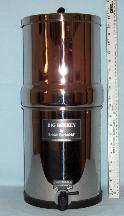
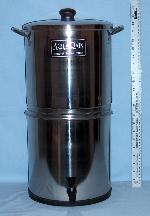
At the current time all three of the above water filters are saturated with fine particles of silver to prevent and retard the growth of pathogens. Early American pioneers frequently put a silver dollar into their water barrels and they left it there because they had learned from experience that it helped to reduce the number of health related problems within their families.
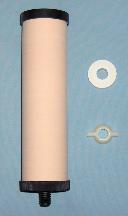 You will need to purchase the following two items:
You will need to purchase the following two items:The copper tubing should have an inside diameter that matches the outside diameter of the steam exhaust port on your pressure cooker. Leave about four-feet at both ends of the copper tubing relatively straight. Wrap the center of the copper tubing into a coil around any cylindrical object that is a few inches smaller in diameter than the inside of the cooling bucket (item 3 above). Remove and aside the cylindrical object after you have successfully coiled the middle of the copper tubing.
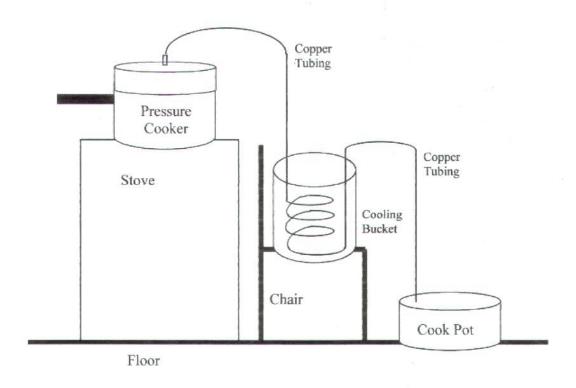
The above procedure will make distilled water but it uses a lot of energy.
There are a variety of other methods for making water safe to drink, such as reverse osmosis and ultraviolet. However, those methods are better suited to normal situations that don't involve long-term survival and the possible absence of electricity.
If you have enough Katadyn Pocket Water Filters for everyone in your group, then you may skip over this section. However, if some of the people in your party don't have their own Pocket Water Filter, then the following information may be of use to you.
To begin with, it is not practical to attach items to the belt which holds your pants up. If you do, those items will pull your pants down as you walk and rub blisters on your hips. Not only is it painful, but it is also very annoying. Therefore, let your normal belt (or suspenders) hold your pants up. Then use another belt for your knife, pistol, first aid kit, and canteen, but don't put that belt through the belt loops on your pants. A belt canteen is usually preferred to a shoulder strap canteen because the shoulder strap wears a blister on your shoulder in a very short time, even when you keep changing shoulders.
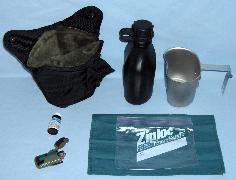
Most canteens are made of light-weight plastic. You can find them at most Army-Navy Surplus Stores. They also usually carry the canteen pouch and the equipment (canteen) belt. Sometimes you can also find a collapsible metal cup that will fit on the bottom of the plastic canteen and fit inside the cloth canteen pouch. The handle of the metal cup is on a hinge and it will fold down and under the cup out-of-the-way. (Note: If you decide to visit an Army-Navy Surplus Store, then ask for an "Alice" type belt with shoulder harness suspender straps. It will cost a little more money but if you do ANY hiking you will probably never regret spending that money. If you purchase the Alice belt, then you should also check out the different types of small equipment bags they sell which attach to that belt. Each small bag can be used to store something different, such as first aid supplies, dehydrated or freeze-dried food, personal care items, or small miscellaneous survival gear such as snare wires and fishing tackle.)
When full of water, the canteen weighs about 2.5 pounds. However, as you walk you will periodically drink some of your water. And if the unexpected occurs, then you may not be able to return to your primary area of safety before nightfall. Therefore, you should also carry the means to replace your drinking water if necessary.
If you add a clean cloth (folded inside a heavy-duty freezer bag) to the inside of your canteen pouch with your canteen, then you will have a method to pre-filter your water. The heavy-duty freezer bag can be used to collect the water, even from a very shallow area. The water can then be poured from the freezer bag through the cloth into your metal cup. This pre-filters the water and removes any large impurities.
You then have two options.
If you have water purification tablets, then you could put the appropriate number inside the water in your cup and wait the specified time. Then you can pour the water into your canteen.
Or you could start a fire IF you have a small butane lighter. Of course you would also need to find some combustible material but in most areas that is not too difficult. Then you can heat the water in your metal cup over the coals from the fire until the water boils. Let it boil for 1 minute (or 2 minutes if you are at the top of an extremely high mountain). Then wait patiently for the water to cool to a safe temperature. Then pour the safe water into your canteen.
You would either boil your water OR you would use your water purification tablets, but you would NOT do both at the same time because they both accomplish the same basic objective. Of the two methods, boiling is best because it positively kills every pathogen in your water source whereas the purification tablets will not be successful against all viruses.
The cloth canteen pouches sold at most Army-Navy Surplus Stores have a small pocket attached to the outside of the canteen pouch. This exterior pocket can be used to store your bottle of water purification tablets which should be placed inside a plastic sandwich bag. And it can also be used to store a miniature butane lighter in a separate plastic sandwich bag. The purpose of the sandwich bags is to protect those items from the condensation moisture from your canteen which will saturate your canteen pouch, or from the rain if it should start to rain unexpectedly while you are hiking.
If you are low on water then don't waste it bathing. I know cleanliness is important but most of us overdo it in the United States. Just wash your hands, face, and feet periodically. Use the two-pot method for bathing. Fill one pot with water and use it as the first rinse after washing your hands with soap, or after bathing with a sponge or wash cloth. Fill another pot with water and use it as the second rinse. Don't discard the wash water in the first pot until it is too dirty to be safely used, and then pour it into the back of your toilet tank so you can use it to flush your toilet, if your sewer system is still working. Then use the second pot as your first rinse and start a new pot of clean water as your second rinse. (Note: The average person probably won't appreciate the true value of their feet until they are confronted with a difficult situation. Then they will suddenly realize that their long-term survival depends on the condition of their feet.)
If you have water pressure and you prefer to take showers, then take a military shower. Close the bath tub drain or put a flat round flexible plastic drain cover over the shower drain. Turn the water on, quickly get soaking wet all over, and then turn the water off. Use some soap to wash your body, and use some shampoo on your hair while the water is off. When you have finished washing and shampooing, turn the water on and quickly rinse the shampoo out of your hair and the soap off your body. Then turn the water off. If you practice this method you will discover you can take a good shower with only three or four gallons of water, and you can then use the shower water that is in the bottom of the tub or shower to flush your toilet, if your sewer system is still working.
Always brush your teeth at least once per day. It doesn't take much water, just a little in a small cup. If you still have water pressure, then do not let the water run while you are brushing your teeth. (Note: Also do not let the water run while you are shaving.) Instead turn the faucet on and put about 2 or 3 ounces of water into a small cup. Then turn the faucet off. Only use a little toothpaste each time and not the amount you normally use. Your toothpaste will last four to six times longer this way with no compromise in dental hygiene. If your sewer system is still working then spit the used mouthful of toothpaste into the toilet bowl. If your sewer system is not working, the spit the toothpaste into the trash can. Rinse your mouth thoroughly after brushing with a small amount of water and spit it into the sink. (Note: If you have a limited amount of water then you do not want to run the risk of having your toothpaste slowly accumulate inside your sink drain and gradually dry out and form a soap block that prevents your drain from working properly. That is the reason you should consider spitting the toothpaste into the toilet stool or trash can.)
Use the three-pot method to wash your eating dishes. Wash your dishes in the first pot of water with dish soap. Rinse the dishes in a second pot. Rinse the dishes again in a third pot. When the dish water in the first pot gets really nasty, pour it down the front of your toilet stool to flush it, if your sewer system is still working. (Note: Dish water usually contains too much food residue and grease to put it in the back of the toilet tank but it can be poured into the front toilet bowl to help flush the stool.) Then put dish soap in the second pot and use it as the initial wash pot. Use the third pot as your first rinse. Add a new pot with clean water as the final rinse.
Hot water, or even warm water, makes it easier to wash your dishes by hand. However, the effort and energy required to heat the water may sometimes exceed the extra manual effort required to simply scrub the dishes a little harder by hand in cold water. That trade-off decision will need to be made by each person based on their own personal circumstances. (Note: Warm water doesn't kill germs. Boiling water kills germs. However, warm water does make grease removal from the dishes much easier. Or you could use enamel coated camping dishes which clean up nicely even in cold water. However, long-term exposure to citric acid will stain the enamel coating on enamel dishes.)
If you are using a standard electric washing machine then do not discard your washing machine water directly into the drain. Move the drain hose to a position above a large empty water container to catch the used wash water. After the first wash cycle, allow the wash water to drain into your water storage container. This soapy wash water can be used in the back of your toilet stool to flush your toilets, if your sewer system is still working. After the washing machine rinse cycle, allow the rinse water to drain into another water storage container. After the washing machine spin cycle is complete, remove your clean clothes, and then transfer the rinse water back into your washing machine. This water is relatively clean and it only contains a little soap residue which will be of use during the next wash cycle. If you will follow this method you will not be wasting any water to wash your clothes, because all of the water will eventually be used to flush your toilets.
If your sewer system is not working then you may use the two pot method for human waste collection and disposal. You will need two large five-gallon containers with lids. When you need to use the toilet, then do so inside one of the two containers. Liquid waste should go into one container and solid waste in the other container. Then immediately replace the lid so most of the odor remains inside the containers. Your local public health authorities will tell you where and how to periodically dispose of this human waste to prevent the spread of a multitude of life threatening diseases.
If your sewer system is working then you may use your toilet. Most new toilet stools are very water efficient and they only require the absolute minimum amount of water per flush. If you have an older toilet stool then it probably uses between four to six gallons of water per flush, which is excessive. However, you can easily reduce the amount of water required per flush. Fill a clean empty 16 to 24 ounce plastic bottle (soft drink or water) with small rocks or pebbles as full as you can, and then finish filling the plastic bottle with water. Replace the bottle cap tightly. Carefully remove the top piece off the rear of your toilet tank and place the full weighted plastic bottle inside the tank. If necessary, secure it with some wire or string inside the toilet tank so that it does not interfere with the normal flushing operation of the toilet. Then flush the toilet to make sure it flushes properly. If you still have some space, then you may add a second and a third filled plastic bottle inside the toilet tank. Just be careful that you do not interfere with the normal flushing operation of the toilet. (Note: Or you could put a brick inside a plastic freezer bag and put it inside the toilet tank instead of using a plastic bottle. Or you could simply replace your old toilet with a new water efficient toilet that uses about 1.6 gallons per flush.)
Only flush human waste and used toilet tissue down your toilet stool. Do not put makeup removal tissues or any other type of used paper in your toilet stool. Instead dispose of these other types of used paper products in an ordinary trash can.
Flushing the toilet each time you use it is not a good idea under hardship conditions. In the country when people occasionally find themselves short on water they follow a very simple rule:
Our bodies are mostly water. Most of the earth's surface is covered with water. Unfortunately, most of it isn't fit to drink. But without water we will all be dead in about three days. Therefore, any information you can acquire about how and where to get drinking water takes you one step closer to being an independent, resourceful human being in God's natural order of things.
Respectfully,
